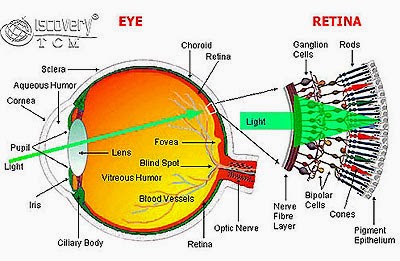Nyctalopia
| Nyctalopia | |
|---|---|
| Classification and external resources | |
Nyctalopia (from Greek νύκτ-, nykt- "night"; αλαός, alaos "blind, not seeing", and ὄψ, ops "eye"), also called night blindness, is a condition making it difficult or impossible to see in relatively low light. It is a symptom of several eye diseases. Night blindness may exist from birth, or be caused by injury or malnutrition (for example, a lack of vitamin A). It can be described as insufficient adaptationto darkness.
The most common cause of nyctalopia is retinitis pigmentosa, a disorder in which the rod cells in the retina gradually lose their ability to respond to the light. Patients suffering from this genetic condition have progressive nyctalopia and eventually their daytime vision may also be affected. In X-linked congenital stationary night blindness, from birth the rods either do not work at all, or work very little, but the condition doesn't get worse. Another cause of night blindness is a deficiency of retinol, or vitamin A, found in fish oils, liver and dairy products.
The opposite problem, the inability to see in bright light, is known as hemeralopia and is much rarer.
Since the outer area of the retina is made up of more rods than cones, loss of peripheral vision often results in night blindness. Individuals suffering from night blindness not only see poorly at night, but also require some time for their eyes to adjust from brightly lit areas to dim ones. Contrast vision may also be greatly reduced. Rods contain a pigment called rhodopsin. When light falls on rhodopsin, it undergoes a series of conformational changes ultimately generating electrical signals which are carried to the brain via the optic nerve. In the absence of light, rhodopsin is regenerated. The body synthesizes rhodopsin from vitamin A, which is why a deficiency in vitamin A causes poor night vision.
Refractive "vision correction" surgery is a widespread cause of nyctalopia due to the impairment of contrast sensitivity function (CSF) which is induced by intraocular light-scatter resulting from surgical intervention in the natural structural integrity of the cornea.[1]
Causes
- Retinitis pigmentosa
- Retinal detachment
- Certain medications, such as phenothiazines[2]
- Oguchi disease
- Pathological myopia
- Cataract
- Refractive surgery (LASIK, photorefractive keratectomy, radial keratotomy)
- Sorsby's fundus dystrophy (Macular degeneration)
- Vitamin A deficiency
Historical usage
Aulus Cornelius Celsus, writing ca. 30 AD, described night blindness and recommended an effective dietary supplement: "There is besides a weakness of the eyes, owing to which people see well enough indeed in the daytime but not at all at night; in women whose menstruation is regular this does not happen. But success sufferers should anoint their eyeballs with the stuff dripping from a liver whilst roasting, preferably of a he-goat, or failing that of a she-goat; and as well they should eat some of the liver itself."
Historically, nyctalopia, also known as moonblink, was a temporary night blindness believed to be caused by sleeping in moonlight in the tropics.[3]
Nyctalopia with animals
Congenital stationary night blindness is also an ophthalmologic disorder in horses with leopard spotting patterns, such as the Appaloosa. It is present at birth (congenital), not sex-linked, non-progressive and affects the animal's vision in conditions of low lighting.[4] CSNB is usually diagnosed based on the owner's observations, but some horses have visibly abnormal eyes: poorly-aligned eyes (dorsomedial strabismus) or involuntary eye movement (nystagmus).[4] In horses, CSNB has been linked with the leopard complex color pattern since the 1970s.[5] A 2008 study theorizes that both CSNB and leopard complex spotting patterns are linked to the TRPM1 gene.[6] The region on horse chromosome 1 to which the Lp gene has now been localized also encodes a protein that channels calcium ions, a key factor in the transmission of nerve impulses. This protein, found in the retina and the skin, exists in fractional percentages of the normal levels found in homozygous Lp/Lp horses and so compromises the basic chemical reaction for nerve impulse transmission.

.jpg)






No comments:
Post a Comment